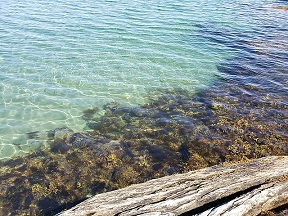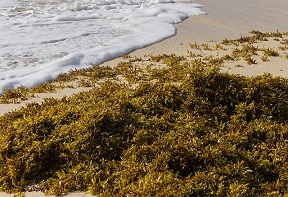At present, most seaweed is grown in Asia. But the North Sea, between England and the European continent, is an attractive location for growing seaweed. This sea is rich in nutrients. Seaweed can be processed to food, useful substances and biogas. However, we need innovations in order for this business to become competitive.

Innovations on seaweed
One of these innovations is being tested this year in Northern Netherlands’ Eemshaven. In this test, seaweed grows in special nets that protect the seeds and little plants. Seaweed farms will be operated more easily by using this dedicated basket. There are far-reaching plans to construct such farms on the North Sea in wind parks, of which a number are under construction right now. Seas are often rough at those locations, far out at sea. The seeds and little plants need protection as they grow. The idea is to grow the crop in between the turbines, where shipping will be restricted anyway. And to harvest the crop when ships visit the wind park for repair and maintenance.
Seaweed as a nutrient is on the rise. For instance, it can be served as if it were a pasta, like developed by Seamore company. There are many seaweed species; they can be used as an alternative to bacon, as a wrap, as a taste enhancer; and in processed form as a mayonnaise. A growing number of people is reviewing their eating habits, for reasons of health and sustainability – then, seaweed offers important opportunities. And some seaweed species, mixed with grass, cause less emissions of greenhouse gases by ruminant cows.

Processing technologies
Often however, the weed needs to be processed in order to extract useful products from it. Seaweed contains proteins and sugars; nutrients that can be processed to fertilizer. Side products can be turned into biogas. But such processes are notoriously difficult, because the resource mainly consists of salty water. That needs to be removed in order isolate the useful products, a cumbersome process that can lead to much corrosion. Therefore, it is a piece of good news that the universities of Exeter and Bath in the UK have developed a process that doesn’t require the salty water to be removed on beforehand. They use acid and alkaline catalysts in the process to produce sugars, and pyrolysis in processing the side product into bio oil and fertilizer.
This technology not just processes the seaweed, but also the plastics that often come with weed harvested on beaches. Therefore, this process is well-suited to use on the Sargassum weed that is washed ashore on Middle American beaches since a few years. There it rots; it emits foul smells and chases away the tourists. There is an urgent need for good processing technologies. But the process that the researchers have developed, still needs to be scaled up.
Interesting? Then also read:
Seaweed biorefinery: much work, high hopes
Seaweed is becoming big business
Sustainable fish farms
